How to find water for a well: an overview of the most effective ways to find water on a site
Installing your own water source in a suburban area will significantly increase the level of comfort.Agree, bringing sufficient quantities of water to the dacha is an expensive undertaking, especially since some areas are significantly removed from the city. Have you decided to build a water intake, but don’t know how to find water for the well?
We will help you understand the intricacies of the search - the article describes various methods and methods that are in demand among owners of suburban areas. There are also video recommendations and colorful photos that clearly demonstrate the material presented.
Taking into account our recommendations, it will not be difficult for you to find water locally. And you will be able to provide yourself with familiar living conditions and a sufficient amount of water for personal use and construction needs.
The content of the article:
Aquifers and location in the ground
There is water underground, but it is not so easy to find. You can, of course, dig a hole at random in the hope of accidentally stumbling upon an aquifer, but the result will most likely be disappointing.
Meanwhile, it happens that if you had not missed by literally two meters, the desired goal would have been achieved.After all, water in the ground is located between layers of soil, which it is not able to erode due to its water-resistant composition, which is based on clay and rocks.
Clay layers alternate with sandy layers, gravel and pebble deposits. They contain clean water. It is precisely this aquifer that those who decide to dig a well on their site need to get to.
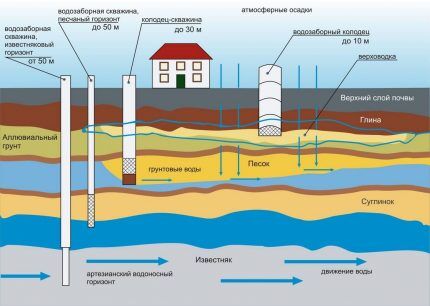
It should be taken into account that the aquifer is not the same in geometric parameters throughout its entire length. Somewhere the sand layer becomes thinner, and in other places it becomes wider and deeper.
The waterproof layer is also not the same: in one place it is horizontal, and in another it can bend or even bend. The largest volumes of water-saturated sand are stored in places where the waterproof layer is bent.
The influence of burial depth on water quality
If you dig a well in the exact place where the water is located, the aquifer can be found even just two or two and a half meters from the earth’s surface. Knowledgeable people call this water layer perchal water and do not use it for drinking.
Proximity to the surface is not a good sign, because water has accumulated due to melting snow, infiltration of rain streams and water from nearby reservoirs. The quality of the water in it leaves much to be desired, because there is a high probability of sewerage and other dirt seeping through.

In addition, the surface of such water is usually unstable. A well with perched water can completely dry up during the summer heat and fill up during the season of melting snow or prolonged autumn rains.
This means that water supply sources fed by perched water will also be empty, and summer residents will be left without water in the hot summer, when it is especially needed. Under such circumstances, it is better to forget about plans for the harvest. After all, no water is expected in the well until late autumn.
Therefore, we will look for deeper water. Experts believe that high-quality water is not so deep, only 15 meters from the soil level. In the sands, where the water is clean and tasty. The sand layer in which water is “stored” is a natural filter. By passing moisture through itself, it cleanses it of residual dirt and harmful elements.
If you are interested in installing a personal water source at your summer cottage, it is worth comparing the arguments in favor of the device well or well, and also learn about their shortcomings. We invite you to read the comparative review.
Observation when searching
The ability to take note of everything and analyze the information collected has never been superfluous. It was in this way that our ancestors, who were not yet armed with the achievements of science and technology, found water. What facts and natural phenomena will help us in our search for water?
Observation #1 - summer fogs
Fogs may appear in the area during the warm season. This natural phenomenon happens either in the early morning or late in the evening. If you observe fog in your area, pay attention to its density: it will be highest in the place where the water is closest to the soil surface.

The cause of such fog is the evaporation of water that is located underground. It will not stay in one place like ordinary fog. Moisture vapor may swirl or travel very low to the ground.
Observation #2 - animal behavior
Unlike people, animals know exactly where underground water is. It's a shame they can't tell us about it. Yes, they won’t be able to tell you, but please share your knowledge.
By observing the behavior of domestic and wild animals and birds, we can obtain all the necessary information:
- Dog. A dog is a man’s friend and will definitely help him in finding water for a well. In the heat, dogs are always looking for an opportunity to cool their body, so they dig holes where it is cooler. These are exactly the places we are looking for.
- Horse. When thirsty, a horse hits its hoof in a place where there is water underground.
- Harvest mouse. But mice love where it is dry. They will never make their nests near places of high humidity. It’s better to climb a tree or some building that rises above the ground level.
- Domestic bird. Chickens do not lay eggs where it is wet, but geese, on the contrary, choose places where underground aquifers intersect for their nests.
Even midges feel the proximity of water. If we look at its behavior at dusk, when the summer heat has already subsided, we will see columns of insects circling in the air precisely over those places where it is coolest - where there is what we need underground.
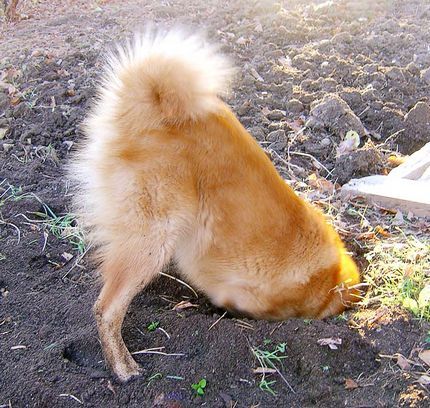
In a place unwittingly indicated to us by representatives of the animal world, we can safely strike Abyssinian well for extracting water for watering the garden and for maintaining the territory.
Observation #3 - types of growing plants
Who would know about the presence or absence of water on the site, if not the plants? It is not surprising that they are used as indicators. If blackberries, buckthorn, lingonberries, bearberry, bird cherry, wood lice and wild rosemary are doing well on your site, then it makes sense to look for an aquifer - it is definitely present.

Take a closer look at the birch: its modest growth and gnarled trunk with curvatures indicate the presence of a nearby watercourse. Coniferous trees also prefer to grow where it is dry.
By the way, the presence of nearby groundwater is not always a benefit for gardeners. After all, cherries and apples prefer moderate humidity: their waterlogging can provoke tree diseases and fruit rotting.
Observation #4 - help from friends and neighbors
If your property is part of a gardening society or you have neighbors nearby, be sure to talk to them. As a rule, they have already solved the problems that you are struggling with today. If there is an operating well or well on their site, then you will have water too.
It is worth asking your neighbors at what depth the water is in their source and whether the level is stable. In this way, it is easiest and simplest to collect information and plan work on well construction. For private owners, surveying the owners of adjacent plots is the only expedient way to obtain hydrogeological data.

Try to find out not only the current state of the local water intake, but also fluctuations in water levels throughout the year, as well as the composition of the water. Agree that it is not very pleasant to find your site flooded with flood waters in the spring. Receive vital information in a timely manner.
Practical Search Techniques
When the observation stage is already over, and the neighbor said that he bought the plot already with a well, the time comes for a practical search for water layers using standard or non-standard methods.
Method #1 - using glass containers
Finding the right number of glass jars of the same size is not a problem for those who occasionally do home canning. If you don’t have cans, buy them; the summer resident will definitely need them sooner or later.

Throughout the entire area, you need to dig glass jars of the same size, bottom up, to a depth of at least 5 cm. The duration of the experiment is one day. The next morning, before the sun rises, you can dig out and turn over the dishes.
We are interested in those jars that contain condensate. There is more of it in banks located above aquifers.
Method #2 - use of hygroscopic material
It is known that salt is hygroscopic, that is, it can absorb moisture even from the air.Red brick, crushed into powder, has the same properties. Silica gel is another material that is perfect for our purposes.
To conduct the experiment, we will need several clay pots that are not covered with glaze. Choose a day when there has been no rain for a long time and we hope that it won’t rain in the next 24 hours.
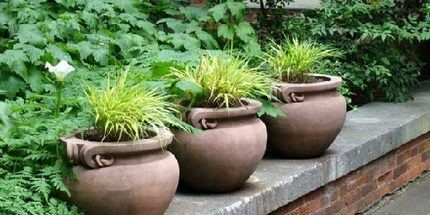
We pour the material into the pots and weigh the resulting “devices”. It is better to number the pots and write down the data obtained. We wrap each pot in non-woven material and bury it at a depth of half a meter in the ground in different places on the site.
A day later we dig up the bookmarks and re-weigh them. The heavier the pot and its contents become, the closer to the place where it was laid the aquifer is located.
Almost scientific methods of dowsing
Despite all the skepticism of professional drillers, dowsing is still used to this day and gives good results. Let's look at two ways to search for water this way.
No. 1 - aluminum electrodes and wire
For this experiment we will need two pieces of aluminum wire 40 cm long. We bend 10 cm on each piece at a right angle for the handles. For the remaining 25 cm, you will need a hollow tube, such as elderberry, with the core removed.
We insert the wire into the elderberry tubes so that it can rotate freely inside the channel. By the way, instead of elderberry you can use viburnum, willow or hazel.
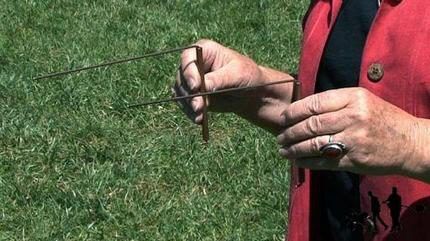
We take one tube in each hand so that their ends point in opposite directions. We walk along the site in the direction from north to south. Elbows should be pressed to the body. The frame, not tightly clenched in the fists, serves as an extension of the hand.
In the place where there is a water-bearing vein, the wires will turn around and converge towards the middle. It is possible that the water may be to your right or left, then both tubes will “look” in this direction.
When you pass the aquifer, the tubes will again turn in different directions. To make sure that you have not made a mistake, walk again over the place where the tubes meet. This time in a direction perpendicular to the previous one (from east to west). If the closure is repeated, the right place has been found and this is where the well should be dug.
No. 2 - willow vine at the heart of the search
We need a willow on which there is a branch that seems to be split into two parts, forming an angle of 150 degrees (approximately) with each other. This is actually a ready-made “frame” - the main tool that we will use. But the frame cannot be used immediately. Be patient and let the wood dry first.
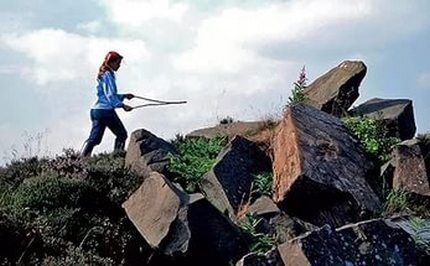
The finished frame is taken at the ends of the branches so that the “beak” located in the middle looks up. With this vine you need to slowly walk around the entire area. Above the location of the aquifer, the vine will “bite”, that is, the middle part of the frame will be directed downward.
Not every person knows how to handle a vine correctly, so dowsing is the destiny of a few. For those who are ready to test themselves, we remind you that the most accurate values can be obtained using the frame:
- in the morning from 6 to 7 o'clock;
- after lunch from 4 to 5 o'clock;
- in the evening from 8 to 9 o'clock;
- at night from 12 to 1 o'clock.
Such research brings results. But the water found may turn out to be high water or underground utilities passing under the site and collecting condensate.
Finding water by drilling
The final result can be obtained by exploratory drilling. He will put an end to all your doubts. To drill a well you will need a garden drill. Since we have already discussed the merits of water located dangerously close to the earth's surface, we will have to drill to a depth of at least 6 meters.
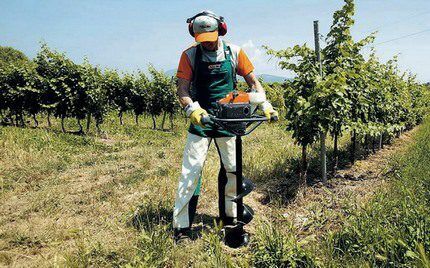
Let's say an aquifer is found. But, before you start digging the long-awaited well, you need to make sure that you have found water of good quality. To do this, send it to the sanitary and epidemiological station to study the composition and degree of contamination. Also water for analysis will need to be handed over after the water intake is installed.
If the results obtained satisfy you, you can consider that the search for a place for a well is completed.
The most expensive and, at the same time, the most reliable method is to drill pits and punch holes using professional equipment.
Using it, we will obtain the following information:
- thickness of the soil on the site;
- quantity and quality of detected water;
- depth of the aquifer;
- location of quicksand, stone blocks and slabs;
- the approximate amount we will need to build a well.
It is not at all a fact that the place you are scouting will be conveniently located relative to the proposed buildings on your site, but sometimes the owners are lucky.
It is considered a great success to find the right place for well digging five meters from your house. In this case, when installing an independent water supply system with automatic water supply, the section of pipes laid in the ground will be minimal. This means it will require less investment.
Conclusions and useful video on the topic
Watch the video below, it will introduce you to dowsing methods. You will see the practical application of the dowsing method. Geologists do not recommend using this method, considering it pseudoscientific. If the method itself is controversial, then the manipulations with the ring that you see in this video are more than questionable.
In our article, dowsing is mentioned solely for the purpose of providing the most complete information about all methods of searching for water that are actually used in practice.
The next video will present the principle of studying soils and their condition using drilling methods. This video clearly demonstrates the work of reconnaissance digging using a probe (bailer). This is a rather labor-intensive process that is difficult to perform alone, without using either a tripod or a gate.
In addition, there is a real danger of the well collapsing if casing is not used to secure it.
If you are looking for water for a well, you need to have an understanding of aquifers, how they are located underground and the influence of water depth on its quality characteristics.
Be observant during your search. Observe plants, natural phenomena and animals. Their behavior will help you determine if there is water in your area.
Folk means of finding water, as well as information received from neighbors, will also not be superfluous. In addition, they search for water using the dowsing method. The drilling method is considered the most effective, although labor-intensive. Armed with the information you have received, you can begin your search. If there is water in your area, you will definitely find it.
Please write comments in the block below. Please ask questions if you have any questions while reading the information we provide. Tell us and site visitors about your own experience in determining the location for a well on a suburban area.




When I was looking for a place for a well, I was guided by two simple methods.At first, my friend and I decided to look for a place where birch trees grow, since there should be water there, but they don’t grow in my area, the method failed. Then I decided to use the method with jars, I simply stuck them into the ground and looked for those with the largest amount of condensation - this method really helped. Now I have a good well and no problems.
Dogs and horses are the best helpers in finding underground water. Naturally, not everyone has horses galloping around their property in herds, but a dog, especially a village dog, will immediately let you know where underground there is the necessary coolness. You just need to prevent her from running away somewhere into a kennel or into the house. And it is desirable that the temperature be at least +25. By the way, I have quite a lot of birch trees on my site, I need to take them into service.
The best way to detect water on a site is to drill a test well. Not the cheapest, but the most effective way. Yes, you can stick bottles into the ground and walk around with wire, but these are unscientific methods and they will never give a 100% result. It’s better to spend money and work with a drill than to dig 10 rings of soil in vain and not find water, or find water of poor quality. The wire will not show the alkalinity or hardness of the water.
We have birch trees growing everywhere and fogs everywhere. You can drill anywhere, but the water is oversaturated with divalent iron. There was a 20-meter well with good water, but after a strong flood, iron water began to flow. And where to look for good water now?
Most likely, you have a problem with melt water getting into the wellhead. Perhaps the clay lock around the casing was not made correctly, or you did not do it at all.
Good afternoon The most reasonable way to find a place for a well or borehole is to scan the area with a radiator; such a technique exists. Allows you to see the location, amount of water and depth.
The plot is narrow, they say there are no veins... What to do - where to dig a well?
Hello. Who said that he lived no? It’s difficult to answer you right away, we don’t know the region, whether the neighbors have water, or the terrain features, but we would advise you to invite an experienced person to look for water for the well. I seriously doubt that there is no water on the site at all.
Hello! There is one empty well with 15 rings on the site. They deepened it, cleaned it, put a shield with magic stones at the bottom, but there was still no water. Task: to accurately determine the place where there is water. The options “tell me where, and we’ll dig it up” or “water is everywhere, you just have to drip” are NOT SUITABLE! You need exactly the EXACT place.